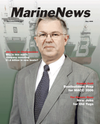
Page 13: of Marine News Magazine (May 2006)
The Combat Craft Annual
Read this page in Pdf, Flash or Html5 edition of May 2006 Marine News Magazine
with export control laws, implementation of a compliance plan, access controls including badging requirements and seg- regated work areas for foreign nationals, periodic training and audits, and flow down of requirements to sub-contractors.
As originally proposed, the new clause stated that "in performing this contract, the Contractor may gain access to export- controlled information or technology" and required the Contractor to "comply with all applicable laws and regulations regard- ing export-controlled information and technology, including registration in accordance with the" ITAR (emphasis added). "Export-controlled information and technology" was defined to mean information and technology subject to export controls under the ITAR or EAR.
Unfortunately, however, although a clause in this format would serve to alert con- tractors to the existence of the export con- trol regulations, it would not identify with any precision the specific controlled tech- nology that might be used or generated during contract performance. Thus, under the proposed rule, as under the currently applicable export control regulations, con- tractors will still have to familiarize them- selves with the USML and the CCL in order to ensure contract and regulatory compliance.
Determining whether information, tech- nology or software is listed on the USML or CCL and thus export-controlled is no easy task. While the CCL contains a very specific list of controlled items and relat- ed software and technology (including items falling under the Navigation and
Avionic, Marine, and Propulsion System categories), the USML is expressed in more general terms, with the result that contractors frequently assume that the "COTS" products they are supplying are not controlled. For example, Category VI of the USML covers, among other things, "Vessels of War" - defined to include not only combatants, but also non-combatant auxiliary vessels and support ships and service and miscellaneous vessels, as well as Coast Guard cutters and patrol craft.
Category VI(f) controls "all specifically designed or modified components, parts, accessories, attachments, and associated equipment" for such vessels, while Cate- gory VI(g) controls technical data (includ- ing software) and defense services direct- ly related to such vessels and components (emphasis added). Any modification to what may appear at first glance to be a standard commercial component or part could subject the contractor to ITAR juris- diction.
One of the most controversial aspects of the original proposed contract clause was the requirement that contractors imple- ment compliance plans that included, among other things, unique badging requirements for foreign nationals and segregated work areas for export-con- trolled information and technology. In this respect, the clause represented a marked departure from current export control regulations. Although both BIS and DDTC recommend that contractors implement compliance programs and have published guidelines for use by con- tractors and exporters who choose to do so, neither the EAR nor the ITAR explic- itly require such programs, and both agen- cies traditionally have declined to dictate the specific operating procedures that should be adopted as part of an effective program. However, even though export
May, 2006 • MarineNews 13
LEGAL BEAT
Circle 221 on Reader Service Card
M/V Kulamanu (Golden Bird)
USCG #250603 1,000 Passenger Vessel
Ordered SOLD by: Osceola Cruises, Inc. dba Pacific Cruises
Thursday - July 20th @ 2:00 PM (on-site)
Pier 7A-181 Ala Moana Blvd. Honolulu, Hawaii
Suggested
Opening Bid 850K
Pier 7A Next to Maritime Museum
WHY AN AUCTION?
The owners have elected to market the M/V Kulamanu via the accel- erated selling method thereby eliminating additional carrying costs that are incurred with conventional marketing and passing these sav- ings on the new owners.
Inspection By Appointment
Broker Participation Welcomed
Registration & Due Diligence
Details available on our website
Inspection Coordinator:
MIKE VAUGHN
Attorney at Law (562) 592-9350
HISTORY OF THE VESSEL
The Kulamanu was originally built in 1946 in Wilmington,
Delaware by Lancaster Iron Works. It was converted to a four- master barkentine passenger vessel under Subchapter H in 1980.
She is U.S. Coast Guard certified for 1,000 passengers and a crew of up to 60 for a total of 1.060 persons. She has been primarily operating for dinner cruises every evening off Waikiki Beach with occasional special daytime charters. Her marine crew is approx- imately 14 persons.
Measuring a full 282 feet long and 55 feet wide, the Kulamanu is licensed to carry 1,000 passengers. Her four masts stand 131-feet above the water, there are four decks giving her a romance and appeal which is truly unique.
The vessel is all steel-welded with a long bow sprit and has four steel masts that carry small sails, essentially for visual and aes- thetic purposes. The vessel is powered by twin 1,000 hp Superior engines. www.marineauctionservices.com
U
N
P
R
E
C
E
D
E
N
T
E
D
O
P
P
O
R
T
U
N
I
T
Y
Dining
MAY MN2006 2(9-16).qxd 5/9/2006 9:14 AM Page 13

 12
12

 14
14
